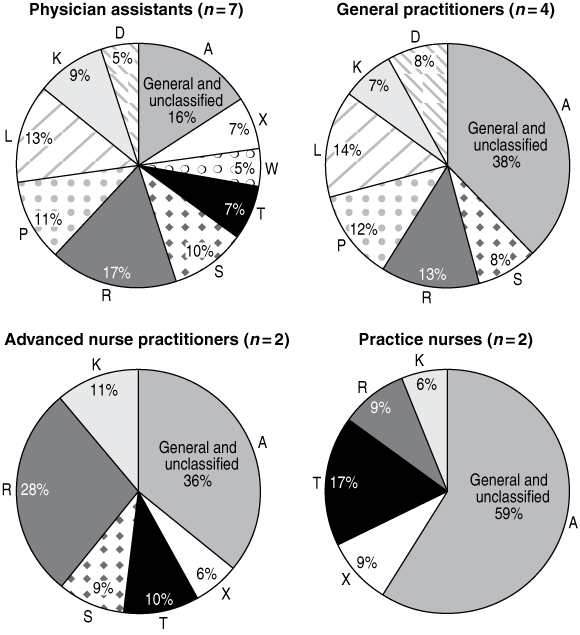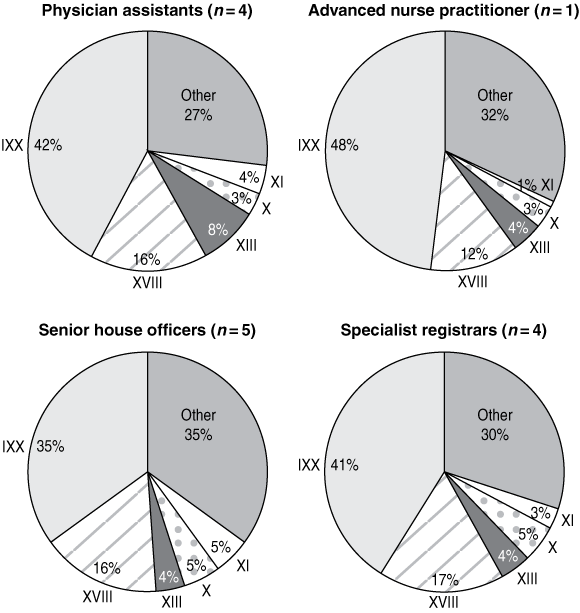There is a looming crisis in clinical care in the United Kingdom. The ageing population,1 rising patient expectations and a culture of consumerism2 are increasing the demand on clinical services. At the same time, several factors are reducing whole-career service provision of the frontline medical workforce. These include demographic factors,3,4 such as the increase in the proportion of female medical graduates to almost 60%;3 issues of balancing work and other aspects of life, leading to earlier retirement; and changes in doctors’ working patterns (eg, the European Working Time Directive5 will result in increasingly tighter legal limits on doctors’ working hours).
In geographic areas of severe socioeconomic deprivation, medical workforce shortages, particularly in primary care, are often an additional problem. A shortage of general practitioners in the West Midlands region of England led several practices to recruit physician assistants (PAs) trained in the United States to support the delivery of core primary care services. The American Academy of Physician Assistants describes PAs as “health care professionals licensed to practice medicine with physician supervision” and, within the physician–PA relationship, to exercise “autonomy in medical decision making and provide a broad range of diagnostic and therapeutic services”.6 The definition would hold equally well for the medical care practitioner role now emerging in the UK.
Favourable early experience encouraged an initiative to import an additional 10 PAs to work predominantly in primary care. Two PAs were also recruited to work in accident and emergency (A&E) departments. This “grass roots” response to the severe shortage of medical workforce was consistent with the UK Government Department of Health’s national policy to introduce more flexibility into health care delivery.7 The widening gap foreseen between a rising demand for health care in the UK and the available clinical workforce stimulated a study of the West Midlands’ experience. This found that the PA model could make a significant contribution to the delivery of clinical care in the National Health Service (NHS). Other regions in the UK have responded to shortages in their clinical workforce by using advanced nurse practitioners (ANPs: nurses designated as having a higher level of expertise in a particular field) in related roles, or have recruited doctors and nurses from overseas. The former is commented on below. Recruitment of health professionals from overseas and the consequent denuding of local services raises significant political and moral issues, and the UK government has developed a code of practice intended to reduce such recruitment.8
In the West Midlands, we have developed our educational proposals by involving local primary and secondary care trusts and the Strategic Health Authority in regular meetings to ensure that fitness for purpose as well as pragmatic issues such as training placements are considered.
Although also involved in aspects of licensing and regulation, the core task of the National Steering Group was to develop a statement of competences for the qualifying MCP and a curriculum framework for institutions wishing to offer educational programs leading to qualification. The decision of the group to develop a framework, as opposed to a fully fledged national curriculum, allows individual higher educational institutions to design programs that meet national criteria but take account of local circumstances. The National Steering Group developed a detailed consultation document to enable both the competences and the framework to be considered more widely through public consultation.9 The outcome of the consultation is expected to be available in July 2006.
To inform its nascent plans for developing an MCP role based on the PA model, the Department of Health commissioned the Health Services Management Centre at the University of Birmingham to evaluate the impact of the initiative to recruit US-trained PAs.10 Methods included collection of both quantitative data (relating to the clinical service activity of the PAs) and qualitative data (by interviews, surveys and focus groups) to determine the views of doctors, nurses and patients regarding the roles taken by PAs in primary care and in hospital A&E departments. The number of PAs working in the region grew considerably during the period of the evaluation, and this is reflected in the data collected. This changing picture meant that the evaluation could not utilise even a quasi-experimental design. As a result, even the quantitative data must be viewed as largely descriptive, and formal statistical analysis as inappropriate.
PAs and their supervising GPs had a similar spread of activity across the 17 chapters of the International classification for primary care (ICPC),11 but there were considerable differences between the activity patterns of GPs and PAs and those of practice nurses and ANPs (Box 1), although the number of nurses sampled is small. Ten per cent or more of GPs’ and PAs’ activity was coded in each of three ICPC chapters — psychological, respiratory and musculoskeletal — although the differences in the activity of each of the professional groups are indicative of differences in their professional roles. The variations in activity pattern between individual practitioners are also indicative of prior experience, subspecialisation and practice organisation.
Although US-trained PAs are qualified to prescribe medication and are allowed to do so in most US states,7 they are not legally permitted to prescribe in the UK. Across seven of the practices surveyed, by far the most common reason for the PA contacting their supervising GP about a particular patient (38%–68% of all such contacts) was to seek a signature on a prepared prescription. By contrast, only 1%–16% of such contacts were for the purpose of reviewing treatment plans. The need for a supervisor’s signature on every PA prescription caused considerable inconvenience for patients because of delay in issuing their prescriptions. Inability to sign a prescription also seriously curtailed home visits by PAs. We anticipate that this anomaly will be rectified once the UK develops a registration process for MCPs, when prescribing rights will be included as an essential competence (as outlined in the current national consultation document, The competence and curriculum framework for the medical care practitioner9).
In addition to shortages of doctors in primary care, A&E services and hospitals at night are also seriously affected by changes to the working hours of doctors in training and the conditions imposed by the European Working Time Directive. A preliminary evaluation of the PA role in A&E was conducted in two hospitals over a 2-month period during 2004. After an induction program of 3–4 weeks, four PAs (two full-time equivalents) in one of the hospitals saw 8% of all attendees. Across the hospitals, three of the four PAs saw 12%–24% of ambulance patients, and this was similar to the proportion seen by the clinical assistants (experienced GPs working sessions in the A&E department), and by the one ANP. The PAs’ caseload was characterised by fewer ambulance cases and lower admission rates than that for the specialist registrars (doctors in specialist training programs) and senior house officers (doctors in the prespecialist phase of training) in the same clinical setting. Data on first attendance for injuries and for chest or abdominal and pelvic pain (International classification of diseases, 10th revision [ICD-10]12 Chapter XVIII; R07, R10) indicate that PAs, clinical assistants, senior house officers and most specialist registrars saw a similar proportion of urgent and non-urgent patients in this category. The proportion of urgent and non-urgent cases was again broadly similar for all categories of clinicians, except for specialist registrars. The clinical caseload across ICD-10 chapters was similar for PAs and doctors, as was found with the ICPC chapter analysis in primary care. However, unlike primary care, a similar pattern was also found for the ANP (Box 2).
The issue of prescribing rights is inextricably linked to that of professional registration. There is already legislative action in the UK to further extend prescribing rights to suitably experienced nurses and to some members of appropriately registered health professions.13 For PAs and MCPs, however, the position is somewhat different, because prescribing is central to their role. Whereas other professions may have been well established before seeking prescribing rights, it is essential to the success of the MCP role that the establishment of the regulatory framework for the MCP profession and the legislation enabling registration of MCPs with prescribing rights are made concurrently.
1 Primary care activity by the International classification for primary care (ICPC) chapter headings
 Key to ICPC chapter headings11 |
2 Accident and emergency activity by the International classification of diseases, 10th revision (ICD-10) chapter headings
- Jim V Parle1
- Nick M Ross2
- William F Doe3
- Medical School, University of Birmingham, Birmingham, UK.
We acknowledge with gratitude the work of Juliet Woodin, Hugh McLeod, Richard McManus and Kim Jelphs, whose survey10 provided the data summarised in the section dealing with the impact of US-trained PAs on primary care and emergency care in the NHS.
None identified.
- 1. Shaw C. 2002-based national population projections for the United Kingdom and constituent countries. Popul Trends 2004; (115): 6-15.
- 2. Will consumerism lead to better health [editorial]? Lancet 2005; 366: 343.
- 3. Jones L, Fisher T. Workforce trends in general practice in the UK: results from a longitudinal study of doctors’ careers. Br J Gen Pract 2006; 56: 134-136.
- 4. Davidson JM, Lambert TW, Parkhouse J, et al. Retirement intentions of doctors who qualified in the United Kingdom in 1974: postal questionnaire survey. J Public Health Med 2001; 23: 323-328.
- 5. Department of Health. European Working Time Directive. Available at: http://www.dh.gov.uk/PolicyAndGuidance/HumanResourcesAndTraining/WorkingDifferently/EuropeanWorkingTimeDirective/fs/en (accessed Mar 2006).
- 6. American Academy of Physician Assistants. Information about PAs and the PA profession. Available at: http://www.aapa.org/geninfo1.html (accessed Mar 2006).
- 7. NHS Modernisation Agency. Changing workforce programme: new ways of working in health care. Available at: http://www.modern.nhs.uk/scripts/default.asp?site_id=15 (accessed Jun 2006).
- 8. Department of Health. Code of practice for the international recruitment of healthcare professionals (2004). Available at: http://www.dh.gov.uk/PublicationsAndStatistics/Publications/PublicationsPolicyAndGuidance/PublicationsPolicyAndGuidanceArticle/fs/en?CONTENT_ID=4097730&chk=DI/b1A (accessed Mar 2006).
- 9. Department of Health. The Competence and Curriculum Framework Steering Group on behalf of the Medical Care Practitioner National Programme Board. The competence and curriculum framework for the medical care practitioner: a consultation document. Available at: http://www.dh.gov.uk/PublicationsAndStatistics/Publications/PublicationsPolicyAndGuidance/PublicationsPolicyAndGuidanceArticle/fs/en?CONTENT_ID=4123769&chk=YE6wNc (accessed Mar 2006).
- 10. Woodin J, McLeod H, McManus R, Jelphs K. Evaluation of US-trained physician assistants working in the NHS in England. The introduction of US-trained physician assistants to primary care and accident and emergency departments in Sandwell and Birmingham. Final report. Birmingham, UK: University of Birmingham, 2005. Available at: http://www.hsmc.bham.ac.uk/publications/pdf-reports/Physician%20Assistant%20final%20report.pdf (accessed Mar 2006).
- 11. International Classification Committee for WONCA. ICPC-2. International classification for primary care. 2nd ed. Available at: http://www.globalfamilydoctor.com/wicc/sensi.html (accessed Mar 2006).
- 12. World Health Organization. International statistical classification of diseases and related health problems. 10th revision. 2003. Available at: http://www3.who.int/icd/currentversion/fr-icd.htm (accessed Mar 2006).
- 13. Department of Health. Nurse and pharmacist prescribing powers extended. Available at: http://www.dh.gov.uk/PublicationsAndStatistics/PressReleases/PressReleasesNotices/fs/en?CONTENT_ID=4122999&chk=Mjc1MS (accessed Mar 2006).






Abstract
A range of demographic, social and other factors are creating a crisis in the provision of clinical care in the United Kingdom for which the physician assistant (PA) model developed in the United States appears to offer a partial solution.
Local and national moves are underway to develop a similar cadre of registered health care professionals in England, with the current title of medical care practitioners (MCPs).
A competence and curriculum framework document produced by a national steering group has formed the basis for a recent consultation process.
A limited evaluation of US-trained PAs working in the West Midlands region of England in both primary care and acute secondary care suggests that PA activity is similar to that of doctors working in primary care and to primary care doctors working in the accident and emergency setting.
The planned introduction of MCPs in England appears to offer, first, an effective strategy for increasing medical capacity, without jeopardising quality in frontline clinical services; and, second, the prospect of increased flexibility and stability in the medical workforce.
The deployment of MCPs may offer advantages over increasing the number of doctors or taking nurses out of nursing roles. The introduction of MCPs may also enhance service effectiveness and efficiency.